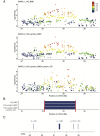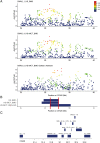Identification of common predisposing loci to hematopoietic cancers in four dog breeds
- PMID: 33793571
- PMCID: PMC8016107
- DOI: 10.1371/journal.pgen.1009395
Identification of common predisposing loci to hematopoietic cancers in four dog breeds
Abstract
Histiocytic sarcoma (HS) is a rare but aggressive cancer in both humans and dogs. The spontaneous canine model, which has clinical, epidemiological, and histological similarities with human HS and specific breed predispositions, provides a unique opportunity to unravel the genetic basis of this cancer. In this study, we aimed to identify germline risk factors associated with the development of HS in canine-predisposed breeds. We used a methodology that combined several genome-wide association studies in a multi-breed and multi-cancer approach as well as targeted next-generation sequencing, and imputation We combined several dog breeds (Bernese mountain dogs, Rottweilers, flat-coated retrievers, and golden retrievers), and three hematopoietic cancers (HS, lymphoma, and mast cell tumor). Results showed that we not only refined the previously identified HS risk CDKN2A locus, but also identified new loci on canine chromosomes 2, 5, 14, and 20. Capture and targeted sequencing of specific loci suggested the existence of regulatory variants in non-coding regions and methylation mechanisms linked to risk haplotypes, which lead to strong cancer predisposition in specific dog breeds. We also showed that these canine cancer predisposing loci appeared to be due to the additive effect of several risk haplotypes involved in other hematopoietic cancers such as lymphoma or mast cell tumors as well. This illustrates the pleiotropic nature of these canine cancer loci as observed in human oncology, thereby reinforcing the interest of predisposed dog breeds to study cancer initiation and progression.
Conflict of interest statement
The authors have declared that no competing interests exist.
Figures




Similar articles
-
Multi-omics approach identifies germline regulatory variants associated with hematopoietic malignancies in retriever dog breeds.PLoS Genet. 2021 May 13;17(5):e1009543. doi: 10.1371/journal.pgen.1009543. eCollection 2021 May. PLoS Genet. 2021. PMID: 33983928 Free PMC article.
-
Molecular cytogenetic characterization of canine histiocytic sarcoma: A spontaneous model for human histiocytic cancer identifies deletion of tumor suppressor genes and highlights influence of genetic background on tumor behavior.BMC Cancer. 2011 May 26;11:201. doi: 10.1186/1471-2407-11-201. BMC Cancer. 2011. PMID: 21615919 Free PMC article.
-
Gain-of-function mutation in PTPN11 in histiocytic sarcomas of Bernese Mountain Dogs.Vet Comp Oncol. 2018 Jun;16(2):220-228. doi: 10.1111/vco.12357. Epub 2017 Sep 20. Vet Comp Oncol. 2018. PMID: 28929581
-
One Health: Therapies Targeting Genetic Variants in Human and Canine Histiocytic and Dendritic Cell Sarcomas.Vet Comp Oncol. 2024 Sep;22(3):322-339. doi: 10.1111/vco.12988. Epub 2024 Jun 12. Vet Comp Oncol. 2024. PMID: 38867335 Review.
-
Domestic dogs and cancer research: a breed-based genomics approach.ILAR J. 2014;55(1):59-68. doi: 10.1093/ilar/ilu017. ILAR J. 2014. PMID: 24936030 Free PMC article. Review.
Cited by
-
Genome-Wide Analyses for Osteosarcoma in Leonberger Dogs Reveal the CDKN2A/B Gene Locus as a Major Risk Locus.Genes (Basel). 2021 Dec 9;12(12):1964. doi: 10.3390/genes12121964. Genes (Basel). 2021. PMID: 34946912 Free PMC article.
-
Genome-wide methylation patterns from canine nanopore assemblies.G3 (Bethesda). 2023 Nov 1;13(11):jkad203. doi: 10.1093/g3journal/jkad203. G3 (Bethesda). 2023. PMID: 37681359 Free PMC article.
-
Genome-wide association studies of human and rat BMI converge on synapse, epigenome, and hormone signaling networks.Cell Rep. 2023 Aug 29;42(8):112873. doi: 10.1016/j.celrep.2023.112873. Epub 2023 Jul 31. Cell Rep. 2023. PMID: 37527041 Free PMC article.
-
Genomic Analysis of Lymphoma Risk in Bullmastiff Dogs.Vet Sci. 2023 Dec 14;10(12):703. doi: 10.3390/vetsci10120703. Vet Sci. 2023. PMID: 38133254 Free PMC article.
-
Increased risk of cancer in dogs and humans: a consequence of recent extension of lifespan beyond evolutionarily-determined limitations?Aging Cancer. 2022 Mar;3(1):3-19. doi: 10.1002/aac2.12046. Epub 2022 Feb 23. Aging Cancer. 2022. PMID: 35993010 Free PMC article.
References
-
- Rao SR, Somarelli JA, Altunel E, Selmic LE, Byrum M, Sheth MU, et al.. From the Clinic to the Bench and Back Again in One Dog Year: How a Cross-Species Pipeline to Identify New Treatments for Sarcoma Illuminates the Path Forward in Precision Medicine. Front Oncol. 2020;10: 117. 10.3389/fonc.2020.00117 - DOI - PMC - PubMed
Publication types
MeSH terms
Substances
Associated data
LinkOut - more resources
Full Text Sources
Other Literature Sources
Miscellaneous

